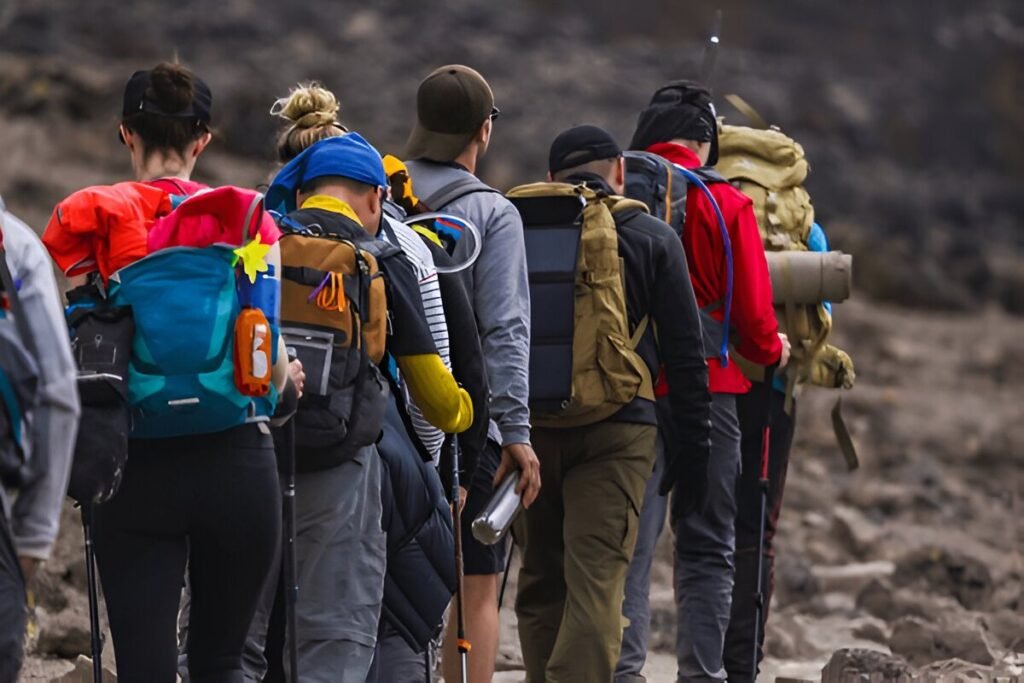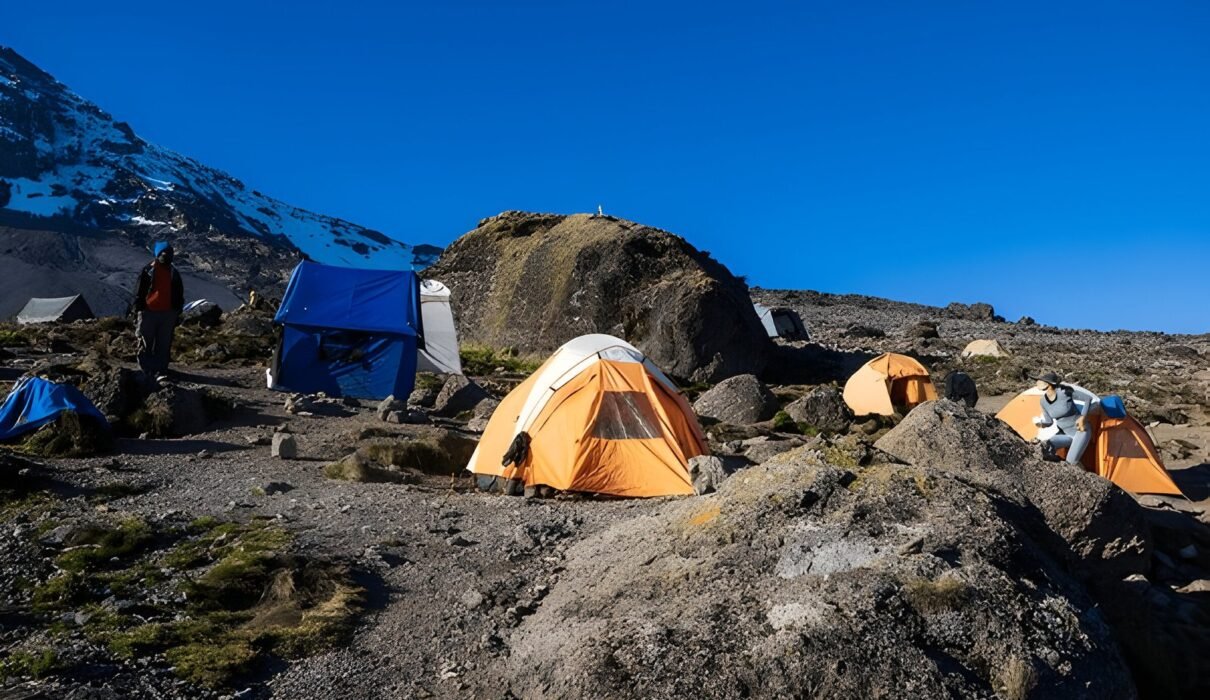Accommodations on climbing Kilimanjaro
Accommodations on climbing Kilimanjaro in 2025 , as most routes don’t have permanent huts. Here’s an overview of the accommodations available on different routes and what to expect in 2025:
1. Camping Accommodations
Most Kilimanjaro routes, including Machame, Lemosho, Rongai, Shira, and Umbwe, are camping-only. Here’s what you’ll typically find with camping:

Tents: Climbing companies provide high-quality, four-season mountain tents that withstand the cold, wind, and occasional rain. Tents usually sleep two, but solo climbers can often have a private tent for an extra fee.
Sleeping Gear: You’ll need a warm sleeping bag rated for temperatures around -20°C (-4°F). Many companies also provide foam mattresses or inflatable sleeping pads for added comfort, though you can bring your own pad.
Dining Tent: Most outfitters set up a separate dining tent with tables, chairs, and lighting, allowing climbers to eat meals comfortably and stay out of the elements.
Toilets: Some companies provide portable, private toilets set up at each camp for hygienic convenience. Otherwise, climbers use the park’s shared pit latrines, which vary in cleanliness.
2. Hut Accommodations on the Marangu Route
The Marangu Route is the only route with permanent huts, making it a unique option for those who prefer not to camp. Key details:
Mandara, Horombo, and Kibo Huts: The Marangu Route has three main hut sites where climbers stay: Mandara Hut (2,720m/8,920ft), Horombo Hut (3,720m/12,200ft), and Kibo Hut (4,720m/15,500ft). Each hut site has a dining area and dormitory-style sleeping arrangements.
Dormitory Beds: Beds are in shared dormitory rooms with foam mattresses and bunk beds, typically sleeping 4-10 people per room. Basic pillows and blankets are provided, but climbers should bring their sleeping bags for warmth.
Dining Halls: Each hut has a dining hall where meals are served.
Shared Toilets: Marangu Route huts offer shared toilet facilities, including flush toilets at lower elevations and pit latrines at higher camps.
3. Meals and Food
Whether camping or staying in huts, meals on Kilimanjaro are typically cooked by a mountain chef and provided by your trekking company:
Breakfast: Porridge, toast, eggs, sausages, fruit, and hot drinks like tea, coffee, and hot chocolate.
Lunch: Packed lunches on the trail or hot meals, including soups, pasta, sandwiches, and fruits.
Dinner: Three-course meals including soup, main dishes like rice or pasta with vegetables and protein (chicken, beef, or lentils), and dessert or fruit.
4. Safety and Amenities
Accommodations are simple but comfortable enough to provide a good rest. Your trekking company usually provides:
Lighting: Solar-powered lights or LED lanterns for dining tents; climbers should bring their own headlamps for night use.
Drinking Water: Treated water is provided at camp each day; climbers are encouraged to bring a water bladder and bottles.
First Aid and Safety Gear: Most companies have oxygen tanks, a first-aid kit, and communication devices at each campsite.
5. Extra Comforts for 2025 Trekkers
For those seeking added comfort, many trekking companies now offer “luxury” packages, including:
Larger Tents: Some companies provide spacious sleeping tents with added insulation.
Additional Padding: Extra sleeping pads or inflatable mattresses for better sleep.
Hot Towels: Some companies offer hot towels for freshening up at camp, a nice perk for multi-day climbs.
Porters: Carry all camping gear, tents, food, and personal belongings, allowing trekkers to focus on the journey.
Accommodations on climbing Kilimanjaro in 2025, Where do i sleep on Kilimanjaro
Where you sleep on Mount Kilimanjaro depends on your hiking route and climbing package. On all but the
Marangu route, you will sleep in tents at designated campsites. Your tour operator will typically organize your sleeping tent and mattress, whereby the quality of tents ranges from cheap locally produced to high-
quality imported winter mountaineering tents or luxurious walk-in size tents with proper frame beds
The Marangu Route offers shared hut accommodation with dormitory-style bunk beds. This means you’ll have a firm roof, but it also reduces your level of privacy. High-quality tents may feel more luxurious and
comfortable than the Marangu Huts.
Accommodations on climbing Kilimanjaro in 2025, What are the facilities on the marangu route like?
All hiking routes on Mount Kilimanjaro are roughly similar in terms of facilities, or lack thereof. You will sleep in designated campsites with basic public toilet facilities.

There are flush toilets and running water at lower altitudes, but only long drop toilets at higher altitude, and no toilets along the path.
Only the Marangu Route offers accommodation in huts and some more facilities, but they are not necessarily more comfortable than the other routes.
For a more comfortable experience, it’s best to book with a high-quality tour operator and upgrade your
climbing package. Mess dining tents with tables and chairs are fairly standard for all mid-range offers, and
private toilet tents have become very popular.
For a true VIP experience. we can add luxuries such as a walk-in size tent with frame beds, a portable
mountain shower, or even a comfortable lounge tent with a heater to your climbing package.
Less popular routes such as the Northern Circuit, Grand Traverse or Rongai Route may also feel more
comfortable as you’ll get to enjoy more privacy, quiet campsites and unspoilt wilderness.
What is the accommodation on the Marangu route like?
The Marangu route is the only route with hut accommodation. This includes 60 bunk beds each at the
Mandara and Kibo Huts and 120 bunk beds at Horombo Hut.
The Marangu Huts offer dormitory-style accommodation of between 4 — 20 bunk beds per room. It is not
possible to rent a private room. Moreover, the allocation of beds is on a first-come-first-served basis.
Therefore, expect to be sharing your hut with strangers.
However, it is worth noting that the huts do not come with mattresses and pillows — tour operators provide
that. You’ll need to bring your own sleeping bags.
The first hut you will stay in will be the Mandara A-frame Huts, which include solar lighting, flush toilets and
piped water.
Accommodations on climbing Kilimanjaro : Includes:
- Kilimanjaro trekking according to the itinerary
- Professional, English-speaking Wilderness First Responder & CPR certified Guide
- Proper Ration of Mountain crew (Cook & Porters)
- Pre and Post accommodations (2 nights Bed and Breakfast)
- Airport Transfers
- Meals according to the itinerary
- Drinking water and Full Board Meals
- All National Park & Hut Fees, Crew Permits and VAT
- Fair and Sustainable Salary Crew Wages
- Gate Transfers
- Complimentary Oxygen Cylinder
- Quality Imported Equipments
Accommodations on climbing Kilimanjaro : Excludes:
- Flights
- Visa fees
- Travel or Medical Insurance is required and you should ask for Recommendation
- Gamow Bag
- Medication
- Tips for porters and mountain crew (20% Industry Standard Recommended)
- Personal spending money for souvenirs etc.
- Energy food & beverages, alcoholic and soft drinks
- Personal hire gear such as trekking poles, sleeping bags, etc.
- Additional lodge nights if early descent from the mountain $150 per room

